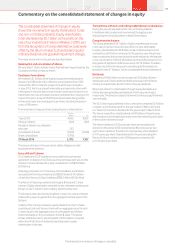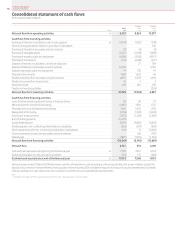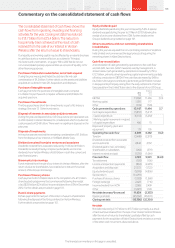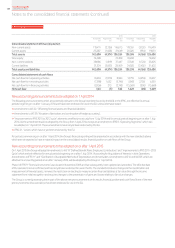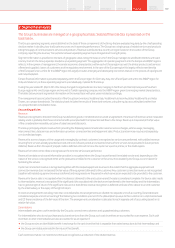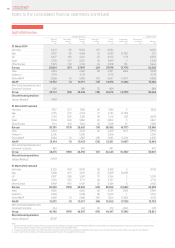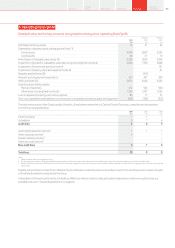Vodafone 2014 Annual Report Download - page 108
Download and view the complete annual report
Please find page 108 of the 2014 Vodafone annual report below. You can navigate through the pages in the report by either clicking on the pages listed below, or by using the keyword search tool below to find specific information within the annual report.
Provisions and contingent liabilities
The Group exercises judgement in measuring and recognising provisions and the exposures to contingent liabilities related to pending litigation
or other outstanding claims subject to negotiated settlement, mediation, arbitration or government regulation, as well as other contingent liabilities
(see note 30 “Contingent liabilities” to the consolidated nancial statements). Judgement is necessary to assess the likelihood that a pending claim
will succeed, or a liability will arise, and to quantify the possible range of any nancial settlement. The inherent uncertainty of such matters means
that actual losses may materially differ from estimates.
Impairment reviews
IFRS requires management to perform impairment tests annually for indenite lived assets and, for nite lived assets, if events or changes
in circumstances indicate that their carrying amounts may not be recoverable.
Impairment testing requires management to judge whether the carrying value of assets can be supported by the net present value of future cash
ows that they generate. Calculating the net present value of the future cash ows requires assumptions to be made in respect of highly uncertain
matters including management’s expectations of:
a growth in EBITDA, calculated as adjusted operating prot before depreciation and amortisation;
a timing and amount of future capital expenditure;
a long-term growth rates; and
a appropriate discount rates to reect the risks involved.
Management prepares formal ve year forecasts for the Group’s operations, which are used to estimate their value in use. In certain developing
markets ten year forecasts are used if it is considered that the fth year of a forecast is not indicative of expected long-term future performance
as operations may not have reached maturity.
For operations where ve year forecasts are used for the Group’s value in use calculations, a long-term growth rate into perpetuity has been
determined as the lower of:
a the nominal GDP growth rates for the country of operation; and
a the long-term compound annual growth rate in EBITDA in years six to ten estimated by management.
For operations where ten year forecasts are used for the Group’s value in use calculations, a long-term growth rate into perpetuity has been
determined as the lower of:
a the nominal GDP growth rates for the country of operation; and
a the compound annual growth rate in EBITDA in years nine to ten of the management plan.
Changing the assumptions selected by management, in particular the discount rate and growth rate assumptions used in the cash ow projections,
could signicantly affect the Group’s impairment evaluation and hence reported assets and prots or losses. Further details, including a sensitivity
analysis is included in note 4 “Impairment losses” to the consolidated nancial statements.
Signicant accounting policies applied in the current reporting period
that relate to the nancial statements as a whole
Accounting convention
The consolidated nancial statements are prepared on a historical cost basis except for certain nancial and equity instruments that have been
measured at fair value.
Basis of consolidation
The consolidated nancial statements incorporate the nancial statements of the Company, subsidiaries controlled by the Company (see note 32
“Principal subsidiaries”) and joint operations that are subject to joint control (see note 12 “Investments in associates and joint ventures”).
Foreign currencies
The consolidated nancial statements are presented in sterling, which is the parent company’s functional currency and the presentation currency
of the Group. Each entity in the Group determines its own functional currency and items included in the nancial statements of each entity are
measured using that functional currency.
Transactions in foreign currencies are initially recorded at the functional currency rate prevailing at the date of the transaction. Monetary assets
and liabilities denominated in foreign currencies are retranslated into the respective functional currency of the entity at the rates prevailing on the
reporting period date. Non-monetary items carried at fair value that are denominated in foreign currencies are retranslated at the rates prevailing
on the initial transaction dates. Non-monetary items measured in terms of historical cost in a foreign currency are not retranslated.
Changes in the fair value of monetary securities denominated in foreign currency classied as available-for-sale are analysed between translation
differences and other changes in the carrying amount of the security. Translation differences are recognised in the income statement and other
changes in carrying amount are recognised inequity.
Translation differences on non-monetary nancial assets, such as investments in equity securities classied as available-for-sale, are reported as part
of the fair value gain or loss and are included in equity.
Notes to the consolidated nancial statements (continued)
1. Basis of preparation (continued)
Vodafone Group Plc
Annual Report 2014106







